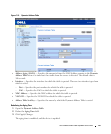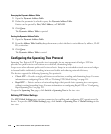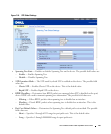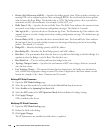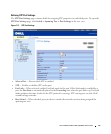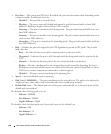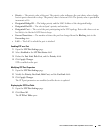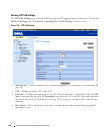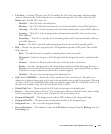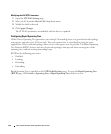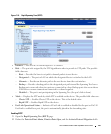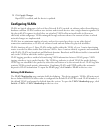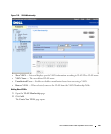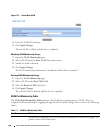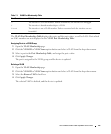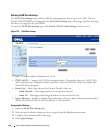
Dell PowerConnect 28xx Systems User Guide 121
•
LAG State
— Current STP state of a LAG. If enabled, the LAG state determines what forwarding
action is taken on traffic. If the bridge discovers a malfunctioning LAG, the LAG is placed in the
Broken
state. Possible LAG states are:
–
Disabled
— The LAG link is currently down.
–
Blocking
— The LAG is blocked and cannot be used to forward traffic or learn MAC addresses.
–
Listening
— The LAG is in the listening mode and cannot forward traffic or learn MAC addresses.
–
Learning
— The LAG is in the learning mode and cannot forward traffic, but it can learn new
MAC addresses.
–
Forwarding
— The LAG is currently in the forwarding mode, and it can forward traffic and learn
new MAC addresses.
–
Broken
— The LAG is currently malfunctioning and cannot be used for forwarding traffic.
•
Role
— Displays the port role assigned by the STP algorithm to provide to STP paths. The possible
field values are:
–
Root
— Provides the lowest cost path to forward packets to the root switch.
–
Designated
— Indicates the port or LAG through which the designated switch is attached to the
LAN.
–
Alternate
— Provides an alternate path to the root switch from the root interface.
–
Backup
— Provides a backup path to the designated port path toward the Spanning Tree leaves.
Backup ports occur only when two ports are connected in a loop by a point-to-point link, or when a
LAN has two or more connections connected to a shared segment.
–
Disabled
— The port is not participating in the Spanning Tree.
•
Path Cost (1-200000000)
— Amount the LAG contributes to the root path cost. The path cost is
adjusted to a higher or lower value, and is used to forward traffic when a path being rerouted. The path
cost has a value of 1 to 200000000. If the path cost method is short, the LAG cost default value is 4. If
the path cost method is long, the LAG cost default value is 20000.
•
Default Path Cost
— When selected, the LAG path cost returns to its default value.
•
Priority
— The priority value of the LAG. The priority value influences the LAG choice when a bridge
has two looped ports. The priority value is between 0-240, in increments of 16.
•
Designated Bridge ID
— The bridge priority and the MAC Address of the designated bridge.
•
Designated Port
ID
— The port priority and interface number of the designated port.
•
Designated Cost
— The cost of the designated bridge.
•
Forward Transitions
— The number of times the
LAG State
has changed from the
Blocking
state to a
Forwarding
state.



